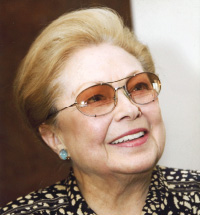Bringing Science to Bear: Questions for Mathilde Krim, Ph.D., amfAR Founding Chairman

Was there a moment in time when it dawned on you that AIDS was going to become a deadly global epidemic?
It was when the first woman and the first baby were diagnosed. The idea at the time still was that only men—only homosexuals—could get the disease. Since we knew already that it was transmissible from one person to the other, it became clear to me that women would transmit it the way men did and babies could get it from their mothers. Is there an amfAR accomplishment that you are particularly proud of?
In my mind, it’s the discovery of the CCR5 HIV receptor. It was already known that there were molecules to which the virus had to attach before entering cells. Two of those had been identified and a third one, CCR5, was discovered by one of our grantees, Dr. Nathaniel Landau. And that was crucial because it is the reason why we need several drugs, several approaches to treatment. This was a great accomplishment and it eventually led to a new class of drugs—CCR5 blockers.
Of all the people you’ve encountered in your work with amfAR over the last 25 years, who has impressed you the most?
One was a young man who worked for amfAR and became a member of the staff of Senator Ted Kennedy. His name was Terry Beirn. The other was Senator Kennedy himself.
One day, I had a call from Senator Kennedy. He was the chairman of a Senate committee dealing with health and he felt very responsible for doing the right thing on AIDS. His staff person in charge of understanding and making recommendations on AIDS was about to have a baby. Did I know somebody who could replace her? I said, yes I do, but I don’t want to give him up. At best I could ask him to work for you part-time. And Kennedy said OK.
Terry reluctantly agreed and he did a perfect job for Senator Kennedy. Terry wanted to start a federal fund to produce and distribute whatever treatments would be available in the future for people with AIDS who couldn’t afford them. So he started lobbying for such a fund and Kennedy said, oh, the government will never do anything like that. But Terry persisted and finally Teddy said, go ahead and try. So Terry went around and managed to get $3 million to start with, and this became the fund that still exists today and is now at $900 million per year.
What sets amfAR apart from other organizations?
From day one, we decided to deal with the fundamental aspects of the AIDS problem. We were mostly people coming from the scientific and medical worlds and we had specialized knowledge that we could exploit in the fight against AIDS.
I remember in the very early days being in Albany to lobby the state government to pay attention to AIDS. A nice little lady came over and she said, “Dr. Krim, we’re so happy to have you here. We hope we can work together.” She said, “I collect money to buy teddy bears to give to all the people with AIDS who are in the hospital.” Teddy bears! For some people, that was the solution and it excused them from doing anything else. I thought we had to be exactly the opposite. We were not about pity in one form or another—we were about solutions.
The second thing is that the people affected by AIDS were being neglected because of their sexual preference. There were members of the public who were full of dislike, animosity, meanness towards gay people. Gay men were accused of creating this problem and spreading it to all the good people. And I think that’s an aspect that amfAR has dealt with very well. And it’s an area where Elizabeth Taylor was a great help.What about a cure – will we have one in the next 10 years? Next 20 years?
Well, we need to define cure. It should be defined as the ability to remove the virus from the body completely or make it totally innocuous. You might still live with the virus but it has to be innocuous. A cure in the next 10 years? Possibly. In the next 20 years? Probably.
Share This:
